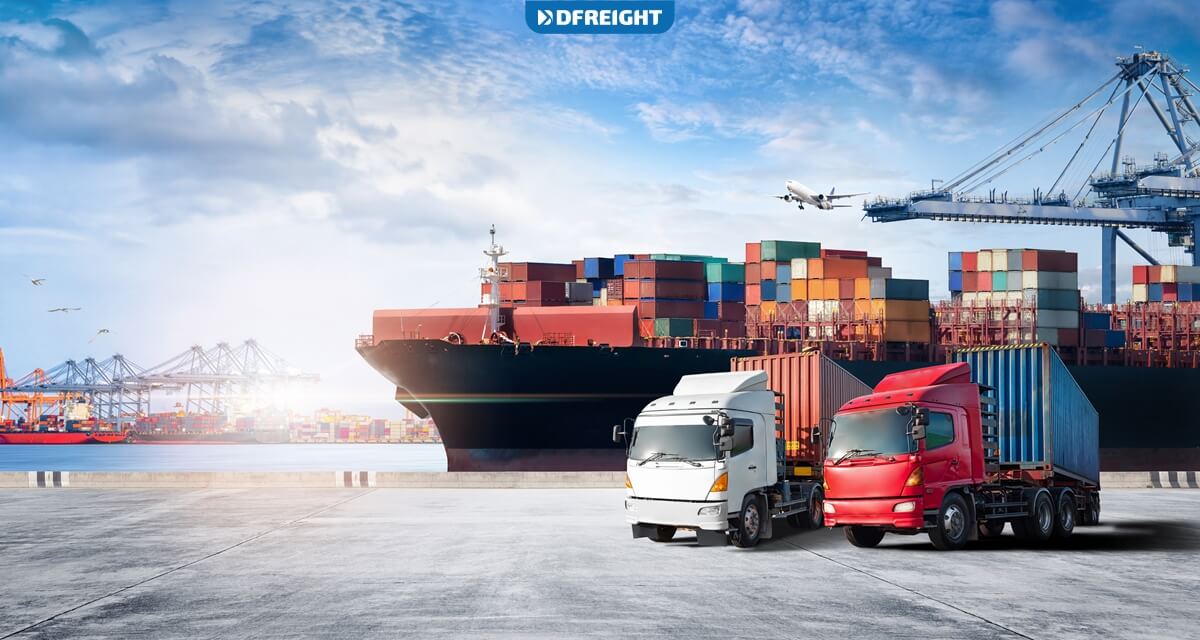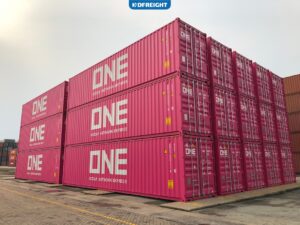In today’s fast-paced and interconnected world, efficient and seamless logistics operations are crucial for businesses to thrive. The traditional methods of handling and transporting goods are rapidly evolving to keep up with the demands of the global market. One of the most transformative developments in logistics is transloading—a game-changing process that is revolutionizing the industry.
This blog post will delve into the world of transloading, exploring its definition, benefits, key components, and its impact on various industries. We will also examine the challenges involved in implementing transloading operations and highlight real-life case studies of successful transloading initiatives.
Discover the future of logistics with DFreight, your digital freight forwarding partner. Streamline your supply chain with ease. Contact us today!
Table of Contents
Understanding Transloading: Definition and Concept
Transloading is a logistics process that involves transferring goods from one mode of transportation to another without the need for direct delivery to the final destination. It is a strategic operation that optimizes transportation routes, improves efficiency, and enhances cost-effectiveness in the supply chain.
At its core, transloading allows for the seamless movement of goods between different transportation modes, such as ships, trains, trucks, and warehouses. This flexibility opens up a wide range of possibilities for businesses to streamline their operations, reduce transit times, and lower transportation costs.
The concept of transloading revolves around leveraging the strengths of different transportation modes to achieve optimal results. For example, a shipment arriving at a port can be efficiently transferred to a truck for delivery to a distribution center located inland rather than relying solely on the more expensive option of shipping directly to the final destination.
The process of transloading involves carefully planning and coordinating the transfer of goods. It requires specialized facilities, equipment, and skilled labor to ensure the safe and efficient handling of the cargo during the transfer. These facilities, known as transloading terminals, act as pivotal hubs where goods are received, sorted, repackaged if necessary, and loaded onto the appropriate transportation mode for onward delivery.
Transloading offers several key advantages for logistics operations. Firstly, it enables companies to access more cost-effective transportation options by utilizing different modes based on their specific strengths and cost structures. This can lead to significant savings in terms of fuel costs, handling fees, and overall transportation expenses.
Secondly, transloading provides increased flexibility and scalability. Businesses can adapt their supply chain to changing market conditions by easily adjusting transportation routes and modes. This agility allows for faster response times, better customer service, and improved overall supply chain resilience.
Additionally, transloading can contribute to sustainability efforts by optimizing transportation routes and reducing the carbon footprint associated with logistics operations. By utilizing more environmentally friendly modes of transportation, such as trains or barges, for longer hauls and then transferring the goods to trucks for local delivery, companies can minimize their impact on the environment.
The Benefits of Transloading for Logistics Operations
From cost savings and increased flexibility to improved efficiency and reduced environmental impact, transloading has emerged as a strategic solution that maximizes the advantages of different transportation modes. Here, we will explore the various benefits of transloading and shed light on why it has become an essential component of modern logistics operations.
Improved Efficiency and Cost Savings
One of the primary benefits of transloading in logistics operations is the improved efficiency it brings to the supply chain. By strategically transferring goods between different modes of transportation, businesses can optimize transportation routes and reduce transit times. This leads to faster delivery and improved overall operational efficiency.
Transloading enables companies to take advantage of different transportation modes’ strengths and cost structures. For example, utilizing cost-effective modes like ships or trains for long-distance transportation and then transferring the goods to trucks for local delivery can significantly reduce transportation costs. This flexibility in selecting the most efficient and economical transportation methods helps businesses achieve substantial cost savings in their logistics operations.
Furthermore, transloading allows for the consolidation and deconsolidation of shipments, which can lead to cost efficiencies. By combining smaller shipments into larger ones, businesses can benefit from economies of scale and lower per-unit transportation costs. Similarly, the deconsolidation of larger shipments into smaller ones enables more precise delivery to specific destinations, reducing the need for excessive transportation and lowering costs.
Enhanced Flexibility and Scalability
Transloading offers businesses enhanced flexibility and scalability in their logistics operations. Seamlessly transferring goods between different transportation modes provides agility and adaptability to changing market conditions.
With transloading, companies can easily modify transportation routes and adjust to fluctuations in demand or changes in customer requirements. This flexibility allows for faster response times, improved customer service, and increased overall supply chain resilience.
Moreover, transloading enables scalability by providing options to expand or contract transportation capacity as needed. Businesses can scale up their operations by utilizing additional transportation modes or facilities to meet increased demand. Conversely, during periods of lower demand, they can scale down by consolidating shipments and optimizing routes, minimizing unnecessary transportation costs.
Reduced Transportation Costs and Carbon Footprint
Transloading plays a vital role in reducing transportation costs and the associated carbon footprint of logistics operations. By optimizing transportation routes and modes, businesses can minimize the distance traveled and reduce fuel consumption and emissions.
Long-haul transportation via cost-effective modes, such as ships or trains, followed by shorter-distance delivery by trucks, can significantly decrease overall transportation costs. This approach not only saves money but also reduces the environmental impact by utilizing more fuel-efficient and environmentally friendly modes of transportation for the majority of the journey.
Furthermore, transloading facilitates the use of intermodal transportation, where goods are moved in standardized containers that can seamlessly transition between different transportation modes. Intermodal transportation reduces the need for cargo handling and repackaging, minimizing the risk of damage and reducing wastage. This streamlined process enhances efficiency and contributes to a more sustainable supply chain.
Businesses can achieve cost savings by reducing transportation costs and optimizing routes while reducing their carbon footprint. Transloading enables companies to align their logistics operations with environmental sustainability goals, making it an attractive option for businesses committed to responsible and eco-friendly practices.
Key Components of Transloading Operation
The success of a transloading operation relies on several key components that work together to ensure a seamless transfer of goods. Here will explore some of the essential elements that constitute a transloading operation:

Transloading Facilities and Infrastructure
Transloading operations rely on specialized facilities and infrastructure designed to facilitate the efficient transfer of goods between different modes of transportation. These transloading terminals serve as crucial hubs where cargo is received, sorted, repackaged if necessary, and loaded onto the appropriate transportation mode.
Transloading facilities typically include loading docks, storage areas, handling equipment, and other necessary infrastructure to support the transfer process. These facilities are strategically located to optimize logistics networks, often positioned near transportation hubs such as ports, rail yards, or major highways.
The layout and design of transloading facilities play a significant role in ensuring smooth operations. Efficient flow patterns, clear signage, and proper safety measures are essential considerations. Additionally, adequate storage capacity and well-organized inventory management systems are crucial to handle the volume and variety of goods efficiently.
Equipment and Technology Requirements
Specific equipment and technology are necessary to facilitate the transfer of goods during transloading. These tools help streamline operations, enhance safety, and improve efficiency.
Equipment requirements may vary depending on the goods being handled but commonly include forklifts, cranes, conveyors, pallet jacks, and loading/unloading equipment. Specialized equipment may be needed for handling particular types of cargo, such as refrigeration units for perishable goods or heavy machinery for oversized cargo or heavy items.
In addition to physical equipment, technology plays a vital role in transloading operations. Tracking and identification systems, such as barcode scanners or radio frequency identification (RFID) technology, enable efficient inventory management and accurate tracking of goods throughout the transfer process. Transportation management software, warehouse management systems, and other logistics software solutions are also critical for seamless coordination and data integration across various transportation modes.
Skilled Labor and Workforce Considerations
Transloading operations require skilled labor and a well-trained workforce to ensure efficient and safe handling of goods. Skilled personnel are responsible for overseeing the transfer process, managing inventory, operating equipment, and maintaining the smooth flow of operations.
Transloading terminals typically employ various roles, including terminal managers, supervisors, equipment operators, warehouse workers, and administrative staff. These professionals must possess the necessary expertise in logistics operations, equipment handling, safety protocols, and inventory management.
Training programs and ongoing professional development are crucial to keep the workforce updated on best practices, new technologies, and safety regulations. Effective communication and collaboration among team members are essential to ensure seamless coordination of activities within the transloading facility.
Labor considerations also include workforce planning and resource allocation. Depending on the volume of goods being handled and the fluctuating demands of the supply chain, businesses must assess staffing requirements and ensure sufficient personnel are available to meet operational needs.
In conclusion, transloading operations involve key components such as specialized facilities and infrastructure, equipment and technology requirements, and a skilled labor force. These components work in tandem to enable efficient and safe transfer of goods between transportation modes. By investing in the right infrastructure, equipment, and workforce, businesses can optimize their transloading operations and unlock the full potential of this logistics revolution.
Industries and Use Cases for Transloading
Transloading has a wide range of applications across various industries, providing significant benefits to businesses in terms of efficiency, cost savings, and improved supply chain management. Let’s explore some key industries and their specific use cases for transloading:
Retail and E-commerce
Transloading plays a crucial role in the retail and e-commerce sectors, where fast and efficient delivery is essential to meet customer expectations. Businesses can optimize their supply chains and streamline their operations by strategically transferring goods between transportation modes.
In retail, transloading enables companies to consolidate shipments from multiple suppliers into larger loads, reducing transportation costs and improving efficiency. For e-commerce companies, transloading can help optimize last-mile delivery by transferring goods from larger vehicles to smaller ones for local distribution, ensuring faster and more cost-effective delivery to customers’ doorsteps.
Manufacturing and Distribution
Manufacturing and distribution industries rely heavily on efficient logistics operations to ensure the timely delivery of raw materials and finished goods. Transloading allows for seamless movement of goods between different transportation modes, optimizing routes and reducing transportation costs.
Manufacturers can benefit from transloading by leveraging cost-effective transportation modes for long-distance shipments and then transferring goods to trucks for local distribution. This approach enables them to access more affordable transportation options while ensuring timely delivery to customers.
Transloading facilitates cross-docking operations in distribution, where goods from various suppliers are consolidated and sorted before being distributed to retail stores or end customers. This process reduces handling and storage costs and improves inventory management.
Agriculture and Food Supply Chain
The agriculture and food supply chain requires careful handling and timely delivery of perishable goods. Transloading plays a crucial role in ensuring the efficient transfer of agricultural products, such as fresh produce, grains, and livestock.
Transloading terminals equipped with specialized storage facilities and temperature-controlled environments help maintain the freshness and quality of perishable goods during the transfer process. By leveraging different transportation modes, such as trucks and trains, agricultural products can be efficiently transported from farms to processing facilities or distribution centers, minimizing spoilage and ensuring timely delivery to markets.
Oil and Gas
Transloading is widely used in the oil and gas industry for the transportation of petroleum products and other related materials. It enables the efficient transfer of goods from pipelines, storage tanks, or refineries to various transportation modes, including trucks, trains, or barges.
Transloading terminals equipped with specialized equipment and safety measures handle the transfer of hazardous materials, ensuring compliance with strict regulations and minimizing the risk of accidents or spills. This process allows oil and gas companies to optimize their logistics operations, reduce transportation costs, and improve supply chain efficiency.
Others
Apart from the industries mentioned above, transloading finds applications in various other sectors, including construction, automotive, mining, and chemicals. These industries often deal with oversized or heavy cargo that requires specialized handling and transportation. Transloading enables the seamless transfer of such goods between different transportation modes, ensuring efficient and cost-effective delivery to project sites or manufacturing facilities.
Additionally, transloading can be utilized in emergency response situations, where the swift transfer of supplies and equipment is critical. Emergency response teams can effectively deliver aid and support to affected areas by strategically deploying resources and utilizing different transportation modes.
In conclusion, transloading offers immense value across diverse industries. Whether it’s optimizing supply chains in retail and e-commerce, streamlining manufacturing and distribution operations, ensuring the timely delivery of agricultural products, managing petroleum logistics, or supporting various other sectors, transloading revolutionizes the way goods are transported, providing efficiency, cost savings, and enhanced supply chain capabilities.
Challenges and Solutions in Transloading Implementation
Transloading implementation comes with its own set of challenges, ranging from infrastructure limitations to regulatory compliance and data management. Overcoming these challenges is crucial to ensure the successful and efficient operation of transloading facilities. Let’s explore some common challenges and potential solutions:
Infrastructure and Connectivity Issues
Infrastructure limitations and connectivity issues can pose challenges to transloading operations. In some cases, existing facilities may not be designed or equipped to handle the specific requirements of transloading. Insufficient storage capacity, lack of proper handling equipment, or inadequate transportation connections can hinder the efficient transfer of goods.
To address infrastructure challenges, businesses can invest in developing or expanding transloading terminals. This may involve constructing new facilities or retrofitting existing ones to meet the demands of transloading operations. Collaborating with logistics partners or utilizing third-party facilities can also provide access to necessary infrastructure without significant upfront investment.
Improving connectivity between different transportation modes is vital for seamless transloading. Establishing efficient transportation networks, optimizing routes, and coordinating with various stakeholders, including shipping lines, rail operators, and trucking companies, can enhance connectivity and facilitate smooth transfers.
Regulatory and Compliance Factors
Transloading operations must comply with various regulatory requirements and safety standards. Regulatory challenges include permits and licenses, hazardous material handling, and environmental and labor regulations.
To navigate these challenges, businesses should stay informed about local, national, and international regulations pertaining to transloading operations. Collaborating with regulatory authorities and seeking guidance from industry experts can help ensure compliance with relevant laws and regulations.
Implementing proper safety protocols, providing adequate training to staff, and conducting regular inspections and audits are essential for maintaining compliance and mitigating risks associated with transloading operations.
Data Management and Information Systems Integration
Transloading involves the coordination of information and data across multiple transportation modes and stakeholders. Efficient data management and seamless integration of information systems are crucial for successful transloading operations.
Implementing robust information systems and leveraging technologies such as transportation management software, warehouse management systems, and data analytics can streamline data management and improve visibility across the supply chain. These systems enable real-time tracking, inventory management, and efficient communication between different parties involved in the transloading process.
Collaboration with transportation partners, suppliers, and customers is essential to ensure smooth information flow and data exchange. Establishing standardized data formats and protocols for data sharing can facilitate integration and improve overall efficiency.
Implementing data security measures and adhering to data protection regulations are also critical to safeguard sensitive information and maintaining data integrity.
In conclusion, transloading implementation comes with its share of challenges, including infrastructure and connectivity issues, regulatory compliance factors, and data management complexities. By investing in infrastructure development, staying compliant with regulations, and leveraging technology for data management and integration, businesses can overcome these challenges and unlock the full potential of transloading operations.
Transloading vs. Traditional Logistics: A Comparative Analysis
Transloading represents a significant shift from traditional logistics methods, offering distinct advantages and improvements in various aspects of supply chain management. Let’s delve into a comparative analysis of transloading and traditional logistics in terms of time and cost efficiency, inventory management and order fulfillment, and customer satisfaction and experience.
Time and Cost Efficiency
Transloading often provides notable time and cost efficiencies compared to traditional logistics approaches. By leveraging the strengths of different transportation modes, businesses can optimize transportation routes and reduce transit times.
Traditional logistics often involve direct delivery from the point of origin to the final destination using a single mode of transportation. This approach may not always be the most efficient or cost-effective, especially when considering factors such as distance, congestion, or transportation rates.
Transloading, on the other hand, allows for the strategic transfer of goods between different modes of transportation. Businesses can achieve significant cost savings by utilizing cost-effective modes for long-haul transportation and transferring goods to more localized modes for final delivery. Transloading also enables the consolidation of shipments, taking advantage of economies of scale and reducing per-unit transportation costs.
Furthermore, transloading provides flexibility to adapt to changing market conditions. It allows businesses to adjust transportation routes and modes based on factors like demand fluctuations, geographic considerations, or cost optimization. This agility improves overall supply chain efficiency, reducing lead times and enhancing responsiveness to customer needs.
Inventory Management and Order Fulfillment
Effective inventory management and efficient order fulfillment are critical factors in logistics operations. Transloading offers advantages in these areas compared to traditional logistics.
Transloading enables the consolidation and deconsolidation of shipments, facilitating more efficient inventory management. By combining smaller shipments into larger loads, businesses can achieve economies of scale, reduce storage costs, and streamline their inventory. Deconsolidation allows for precise delivery to specific destinations, minimizing unnecessary transportation and optimizing order fulfillment.
Moreover, transloading terminals equipped with specialized facilities and technology can enhance inventory visibility and accuracy. Real-time tracking, barcoding, and scanning systems facilitate accurate inventory management, reducing the risk of stockouts or overstocking.
Traditional logistics may face challenges in inventory management, particularly when relying solely on direct delivery to the final destination. In this case, inventory visibility may be limited, making it more challenging to optimize inventory levels and respond promptly to changes in demand.
Customer Satisfaction and Experience
Customer satisfaction and experience are crucial considerations in logistics operations. Transloading can contribute to an enhanced customer experience compared to traditional logistics methods.
Transloading allows for faster and more reliable delivery by optimizing transportation routes and leveraging different transportation modes. This can result in reduced lead times, improved on-time delivery performance, and greater reliability in meeting customer expectations.
Additionally, transloading enables businesses to offer customers more flexible and cost-effective shipping options. By utilizing different modes of transportation, businesses can provide more tailored and affordable shipping solutions based on customer preferences and specific delivery requirements.
Moreover, transloading’s ability to optimize routes and reduce transportation costs can result in competitive pricing for customers. Cost savings achieved through transloading can be passed on to customers, resulting in more competitive pricing structures and potentially higher customer satisfaction.
Traditional logistics, while effective, may face limitations in terms of flexibility and cost optimization. Relying solely on direct delivery may limit the range of shipping options available to customers and could result in higher transportation costs.
In conclusion, transloading offers several advantages over traditional logistics in terms of time and cost efficiency, inventory management and order fulfillment, and customer satisfaction and experience. By leveraging different transportation modes, businesses can achieve cost savings, improve inventory management, and enhance customer service, ultimately gaining a competitive edge in today’s dynamic market.
Embrace Transloading for a Seamless Supply Chain with DFreight, Your Digital Freight Forwarding Partner
In conclusion, transloading is a game-changer in the world of logistics. It offers improved efficiency, cost savings, enhanced flexibility, and a reduced environmental impact. By embracing transloading, businesses can revolutionize their supply chains, gain a competitive edge, and meet the ever-growing demands of the global market. The logistics revolution has begun, and transloading is at its forefront. Don’t miss out on this transformative journey toward a more connected, efficient, and sustainable future in logistics.
What is transloading?
Transloading refers to the process of transferring goods from one mode of transportation to another without the need for direct delivery to the final destination. It optimizes transportation routes, improves efficiency, and reduces costs in the supply chain.
Why is transloading beneficial for logistics operations?
Transloading offers several benefits, including improved efficiency and cost savings. Businesses can optimize routes, reduce transit times, and access more cost-effective transportation options by leveraging different transportation modes. Transloading also provides enhanced flexibility, scalability, and reduced transportation costs and carbon footprint.
Which industries can benefit from transloading?
Transloading has applications in various industries. Retail and e-commerce, manufacturing and distribution, agriculture and food supply chain, oil and gas, and other sectors can all benefit from the efficiencies and cost savings of transloading.
What are the key components of transloading operations?
Transloading operations require specialized facilities and infrastructure, including transloading terminals with storage areas and handling equipment. Equipment and technology requirements include forklifts, conveyors, tracking systems, and logistics software for data management. Skilled labor and workforce considerations are also essential for efficient transloading operations.
How does transloading compare to traditional logistics?
Transloading offers advantages over traditional logistics methods. It improves time and cost efficiency by optimizing transportation routes and leveraging different modes of transportation. Transloading enhances inventory management and order fulfillment by enabling the consolidation and deconsolidation of shipments. It also enhances customer satisfaction and experience through faster delivery, flexible shipping options, and competitive pricing.














